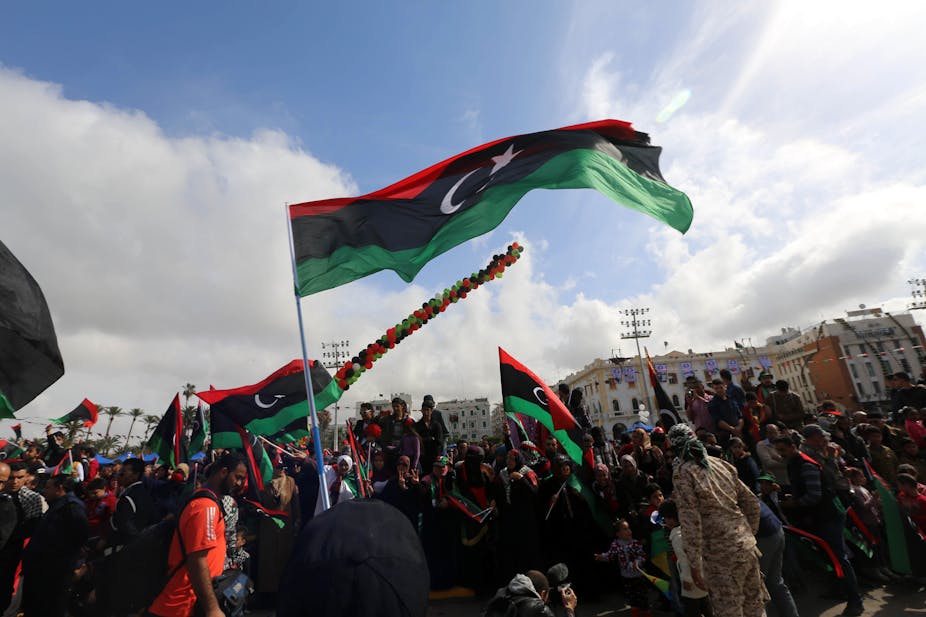Five years after the collapse of Libya, a new UN-backed national unity government has finally been unveiled. It seeks to bring together the existing rival governments in the east and west of Libya, mainly to collaborate in the fight against groups affiliated to the Islamic State. The first elections are planned for 2018. If it is to succeed in building a viable country, however, this new government will first need to make Libya stable again.
Libya’s political system has completely broken down since 2011. What began early that year with protests against the arrest of Fathi Tirbil, a legal advocate for families of the victims of the 1996 Abu Slim prison massacre, soon escalated to a civil war and NATO-led intervention against the government.
After the Gaddafi regime had been overthrown and international observers reported free and fair elections in July 2012, many optimistically foresaw a transition to democracy. Alas, the country’s new political institutions had neither the capacity nor the mechanisms to support a viable system. For example, the National Transitional Council (NTC) – which acted as the interim government – was internally divided and, in any case, was not very representative of the rebel forces that overthrew Gaddafi.
Despite the announcement about the new unity government, Libya is far from united. The government will compete for power with the Tripoli-based General National Congress in the west, which has a consultative role in the new system; as well as the Tobruk-based parliament in the east and various tribal militias and jihadist groups.
Violence flared up again in 2014, as the various competing players struggled over political power and control of energy resources. The country is currently in chaos.
If the new government is to prevail, it must overcome the following three major challenges:
1. State-building and reconciliation
It has to build new democratic institutions out of nothing; during the Gaddafi era nobody participated in politics outside the ruling elites. The previous attempt to establish democracy through the General National Congress has been hamstrung by internal conflict between its political blocs.
Libya is a complex mix of tribal divisions between Arabs, Berbers and Africans from further south. The new government has to achieve a national reconciliation by including everyone. This must be reflected in a new constitution, following the interim constitutional declaration of 2011, which guarantees cultural rights for all Libyans – a reverse of Gaddafi-era discrimination against black African ethnic groups. A Constitution Drafting Assembly produced a draft of a new constitution last autumn, but was seen as flawed and non-inclusive.
2. Oil and social cohesion
It is impossible for Libya to move towards democracy without first reaching a certain degree of economic equality: the EU-funded Arab Transitions project confirmed that in Libya and other Arab Spring nations, economic equality and social justice were key reasons for the upheaval. Central to this is the oil industry, which makes up about 80% of GDP and 99% of government revenue. Unless the wealth is shared around, Libya will always be vulnerable to extremism.
Many of the country’s oil facilities are still occupied by militias and paramilitary groups, which raise enormous funds from exporting it. The future of the national oil company is unclear, with rival political factions competing for control – and the situation is the same with the central bank. Over the past five years, the economy has been severely disrupted. Getting this back on track is vital.

3. Security
The Gaddafi regime was notoriously violent against dissidents. After it was gone, it proved very difficult to make the country secure. The various revolutionary groups were not willing to give up their arms and become loyal to the security forces of the National Transitional Council.
In October 2011 the NTC’s solution was to recruit about 100,000 revolutionaries from these groups to the Supreme Security Committee. It then attempted in 2012 to create an alternative parallel army, the Libyan Shield. This too tried to integrate the militias into state security structures by maintaining their existing battalions and allowing them to be relatively autonomous. Unfortunately it put them on the state payroll without making them very loyal to the government.
Four years on and the struggle between various armed elements, local militias and state security forces is an everyday phenomenon. The state remains fragmented, has little capacity to enforce law and order and does not possess a monopoly over the means of violence. The militias serving under the Supreme Security Committee and Libyan Shield don’t trust the new system, so they don’t function as united entities.
Libya also needs to deal with the growing threat of the Islamic State. This has been made worse by the fact that growing numbers of senior IS fighters from Syria have relocated to Libya since the Russians intervened last year. IS has been using Libya as a launch pad for attacks on the surrounding countries. Solving this problem involves taking weapons out of the wrong hands and making the borders properly secure – working in concert with the likes of the US, which bombed an IS camp at Sabratha in central Libya on February 19, killing 40.

In sum, Libya will remain unstable without reconciliation and proper democracy, and without a new social contract. But until there is a certain level of basic security the situation is likely to get worse. To achieve these things the country’s competing parties must work together. Introducing a new unity government for Libya is one thing – making inroads into the country’s problems is quite another.

